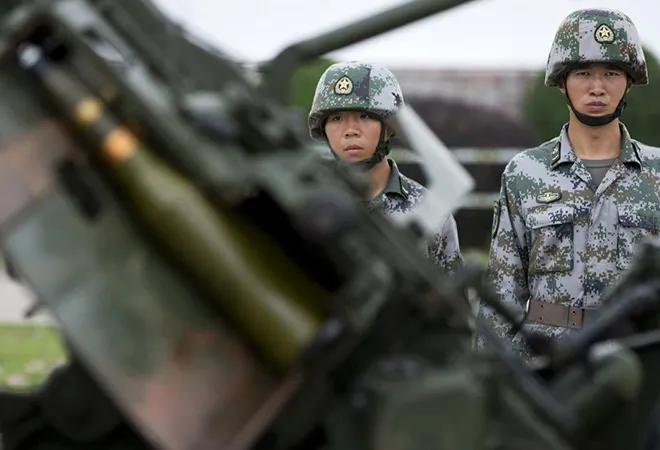-
CENTRES
Progammes & Centres
Location
With top brass of the PLARF being accused of corruption, President Xi’s changes to the PLARF’s leadership implies a rot in the regime’s power hierarchy

It seems all is not well in the Communist Party of China (CPC), and the contagion is spreading into the regime’s power hierarchy. China’s President Xi Jinping, who also heads the apex armed forces authority, the Central Military Commission (CMC), reconstituted the People’s Liberation Army Rocket Force (PLARF), which is in charge of the nation’s nuclear arsenal.
Wang Houbin, the Chinese Navy’s former deputy commander, has been named as PLARF’s head. Xu Xisheng has been shifted from the Southern Theatre Command as the Force’s new political commissar, a position that involves maintaining the Party’s political control over a particular institution. Xu Xisheng is replacing Xu Zhongbo who had been promoted to general in 2020.
Xu Xisheng has been shifted from the Southern Theatre Command as the Force’s new political commissar, a position that involves maintaining the Party’s political control over a particular institution.
The PLARF’s erstwhile leadership—former commander General Li Yuchao, and his deputies Zhang Zhenzhong and Liu Guangbin—is under the scanner for alleged corruption. Li Yuchao was firmly entrenched in the Party’s power structure, given that he is a member of its Central Committee and a deputy to the National People's Congress. The promotion of a rank outsider into a crucial military branch, replacement of those in charge of political control, and launching an inquiry against its former leadership is unusual and represents a deep malaise. This development comes ahead of the People’s Liberation Army’s (PLA) Foundation Day. The rejig assumes significance as it comes close on the heels of the disappearance and dismissal of former Foreign Minister Qin Gang, and the mysterious death of General Wang Shaojun, who headed a unit that oversaw the security of Zhongnanhai, China’s elite leadership compound.
Significantly, China’s economy has slowed down and the unemployment rate in the 16-24 age bracket is 21 percent. Joblessness was among one of the triggers for the Tiananmen Square Massacre, in which China’s youth challenged the Party in the late 1980s. China also witnessed protests in many cities last year against Xi’s Zero COVID-19 policy. A discussion among the ruling elite assesses the “risks and dangers” that the tough economic situation is posing.
In this light, there has been an attempt to rally the forces. Recently, Xi summoned PLA brass to Beijing, where he highlighted the need for better Party oversight over the military. In recent years, Xi has underscored the need for greater loyalty from the PLA, which is the Party’s army. Jiang Tiejun, an academic with the Academy of Military Sciences, reasons that this emphasis on greater loyalty is because the CPC modelled itself on the Soviet Communist Party, and Xi has cited the abandonment of political education as a major reason for the Soviets’ weakened grip over its armed forces, which, in turn, led to its collapse. In addition, the Wagner group’s Yevgeny Prigozhin’s rebellion against Russia’s political-military elite may have also been a factor in the renewed calls for loyalty.
Joblessness was among one of the triggers for the Tiananmen Square Massacre, in which China’s youth challenged the Party in the late 1980s.
Notwithstanding the dramatic personnel changes made by the Xi-led regime, what impact might the purge in the PLARF’s leadership have on the force’s capabilities? The PLARF, which controls Chinese rocket forces and nuclear arsenal, is unlikely to witness any real shift in the trajectory of its capabilities. The PLARF’s capabilities had undergone and were undergoing significant changes prior to the latest reorganisation and it is highly unlikely that the improvement in Chinese rocket and nuclear will be adversely affected by the recent changes. Corruption at the top may have robbed the PLARF and the Chinese military of some sheen, but not the strength of its missile and nuclear forces.
Ever since its inception in 2016, following sweeping military reforms brought about by President Xi Jinping, the modernisation of Chinese missile and nuclear forces under the PLARF has witnessed dramatic growth and transformation, both qualitatively and quantitatively. In terms of quality, the nuclear segment of the PLARF forces includes three Multiple Independently Targetable Reentry Vehicles (MIRVs) to be fitted on the PLARF’s most advanced Intercontinental Ballistic Missile (ICBM), the DongFeng (DF)-41. In addition, China’s rapidly expanding arsenal is being aided by the Russian state-owned nuclear agency, Rosatom, which is supplying enriched uranium to the Peoples Republic of China’ (PRC) Fast Breeder Reactors (FBRs) that will help China produce plutonium-based fissile material. Plutonium is generally the preferred fissile material for atomic weapons.
The PLARF’s capabilities had undergone and were undergoing significant changes prior to the latest reorganisation and it is highly unlikely that the improvement in Chinese rocket and nuclear will be adversely affected by the recent changes.
In quantitative terms, there is likely to be a numerical increase in China’s nuclear stockpile from the current 400 weapons to 1,000 weapons by 2030 and an additional increase of 500 weapons to 1,500 weapons by 2035. Further, apart from an increase in the PRC’s road-mobile ICBM capabilities, the PRC’s silo-based missile capabilities are undergoing significant expansion; the PLARF is in the process of constructing an estimated 300 ICBM silos in China’s northwest. Beyond these changes, the PLARF has already withdrawn older the DF-21A, and potentially the DF-21C missiles as well, replacing them with brand new missile systems—the DF-17 and DF-26, forming the PLARF’s medium- and intermediate-range missile forces. Albeit slower than other areas of change in the PLARF’s inventory, the service’ DF-31A missiles are being replaced with a more advanced variant—the DF-31AG missile.
The sophistication in Chinese missile and nuclear forces is entirely the product of the PRC under Xi Jinping ploughing a considerable amount of resources into the PLARF’s capabilities, which precedes the changes brought about in the command of the service. Thus, the readiness level and modernisation of Chinese missile and nuclear forces are unlikely to be affected by the purge in the leadership of the PLARF. China’s adversaries, including India, must not read too much into the latest developments.
Kartik Bommakanti is a Senior Fellow with the Strategic Studies Programme at Observer Research Foundation.
Kalpit Mankikar is a Fellow with the Strategic Studies Programme at the Observer Research Foundation.
The views expressed above belong to the author(s). ORF research and analyses now available on Telegram! Click here to access our curated content — blogs, longforms and interviews.

Kalpit A Mankikar is a Fellow with Strategic Studies programme and is based out of ORFs Delhi centre. His research focusses on China specifically looking ...
Read More +
Kartik Bommakanti is a Senior Fellow with the Strategic Studies Programme. Kartik specialises in space military issues and his research is primarily centred on the ...
Read More +